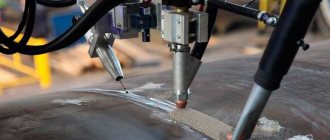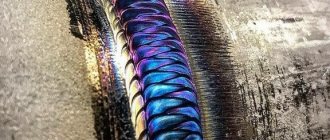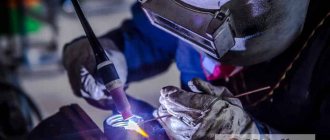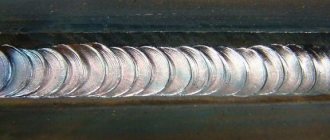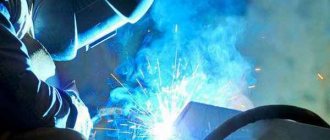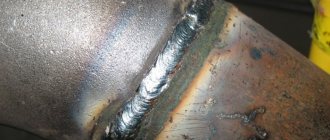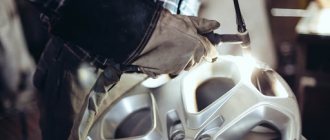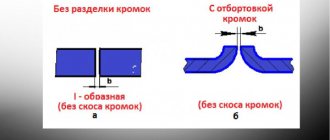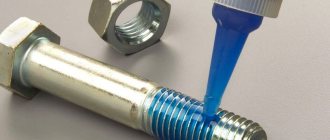Welding various pipes using manual arc welding involves the formation of a high-temperature electric arc at the point of application of the electrode to the surface of the pipe. Under its action, the metal of the electrode melts to a liquid state and flows down in drops to the point of connection of two pipeline elements, the metal surface of which also melts to a semi-liquid state. The metal drops that fall on the joint, solidify, connect the parts together and seal the seam. The slag contained in the electrode floats to the top of the welding melt until it hardens.
The popularity of arc welding is determined precisely by its technological simplicity, as well as the high strength and tightness of the resulting seams.
Arc welding technology
The strength of joints obtained as a result of welding is achieved by heating alloys from different metals with an electric arc and their plastic deformation from exposure to high temperatures. This process leads to the mutual exchange of elementary particles of the electrode and the materials used. Molecular bonds arise that make the fastening permanent.
When approaching pipeline welding with full responsibility, you need to know the main points of welding technology for different materials.
Welding of fixed joints
Three-layer welding is suitable for welding non-rotating joints of a metal pipe. If such joints are welded on pipes with a diameter of up to 1.2 cm, their width should be equal to triple the thickness of the electrode, and the height should not be higher than 0.4 cm. The welding method is forward-return. The arc is made as short as possible - up to 2 mm. The previous layer is covered with the next one by 2-2.5 cm.
Welding of rotary joints
Rotary joints are also welded in three layers. The process occurs in several stages:
- The joint is conventionally divided into 4 parts.
- Weld two of them and rotate the resulting joint 180 degrees.
- Weld the remaining sections.
- Turn the pipe 90 degrees and cook the second layer.
- Rotate the pipe 180 degrees again.
- Re-weld the two remaining parts.
If it is necessary to weld pipes with a diameter of more than 50 cm, a reverse-stage technology is performed:
- The joint is divided into short sections from 15 to 30 cm.
- The pipe is rotated and layers are applied.
Rotary joints with a diameter of up to 20 cm are cooked without dividing into segments. In this case, a continuous seam is used while rotating the pipe. Please note that 2nd and 3rd layers of welding are applied in opposite directions. Adjacent layers overlap by 1-1.5 mm.
Welding of pipelines made of high-strength steels
Reducing the metal consumption of structures during pipeline construction is facilitated by the use of high-strength steel products for these purposes. When working with them, take into account:
- thermal regime that prevents the appearance of hardening cracks and martensite;
- quality of welding materials, which provide increased technological strength of the deposited metal and its equal strength with the base material.
To do this, carry out the following operations:
- according to the penetration conditions, the welding mode is calculated;
- determine the permissible cooling rate of steel after welding.
High-strength steel is welded in two ways:
- with heat treatment of welded joints;
- without heat treatment of welded joints.
Electrodes designed for welding pipes with high strength have a tensile strength of over 590 MPa.
The main advantages of electrodes for welding with subsequent processing of compounds:
- impact strength;
- slight elongation;
- tear resistance.
GOST 9467-75 standards comply with 5 types of non-main material for welding high-strength metal structures:
- E150;
- E1255;
- E100;
- E85;
- E70.
When welding metal structures made of hardened steel without subsequent heat treatment after welding, electrodes are selected that ensure a weld with an austenitic metal structure. As a result, welded joints with increased resistance to cracking are obtained, and the seam itself has high toughness and ductility.
Welding of gas pipelines and pipes for transporting aggressive liquids
Pipelines for transporting aggressive liquids, acids and alkalis, must be separated from other utilities. All connections must be tight, not susceptible to cracks and resistant to high pressure.
Materials for welding must have anti-corrosion and anti-oxidation properties to prevent leakage along the welded joint in rather aggressive environments. When welding a pipeline of this type, it is important to follow and not break the rules in order to avoid unwanted defects.
Special welding work
There are special welding methods that are used only for certain types of products with a specific welding specificity.
Diffusion welding
The formation of bonds at the atomic level due to plastic deformation when metal elements approach each other at elevated temperatures is called diffusion welding.
Compounds obtained by this method have the following advantages:
- environmental friendliness;
- low power consumption;
- maintaining the quality characteristics of the metal parts used;
- slight dependence on external influences;
- a combination of materials with different properties.
Pressure welding
Pressure welding is a type of resistance welding. In its process, the surfaces are under high-intensity pressure, so the connection is obtained without additional heating.
The quality of the seam obtained in this way depends on:
- the efforts made;
- the ability of the metal to be subject to plastic deformation;
- preliminary preparation of material.
In resistance welding, the area being welded is protected using an inert gas environment.
Special types of welding work also include:
- thermite welding;
- friction welding;
- explosion welding;
- electron beam welding;
- pulsed arc welding.
Electroslag welding
This type of welding is based on a process in which an electric current passes through the molten slag and the electron energy is converted into heat.
Distinctive characteristics of electroslag welding are low concentration of energy in the heating area and a large heating zone.
Laser welding
Laser radiation is a highly concentrated source of heating. They are used by an optical quantum generator.
It has a number of advantages compared to other types of welding:
- increased cooling and heating rates, which reduce the area of thermal impact and reduce the likelihood of qualitative changes in the metal;
- the beam can be transmitted over considerable distances, which makes welding possible in hard-to-reach places;
- The deformation of parts is reduced tenfold, thanks to a narrow but deep seam.
Working with gas pipelines and pipes for transporting aggressive liquids
Ceramic spacers are used to form the root seam. They are attached to the reverse side and form molten metal, preventing it from leaking out. Ceramic gaskets prevent porosity, undercuts and sagging.
Welder of the 6th category, foreman of a team of welders of equipment for the food and chemical industries Boroday N.S.: “When welding critical pipes and stainless steel containers, the formation of beads on the inside is not allowed. When laying the root weld, it is necessary to ensure that argon is blown into the welding area. If it is impossible to use argon locally, it is pumped into a container or pipe, ensuring airflow throughout the entire root weld welding with an intensity of 3 - 4 l/min. When accessing the inside of the structure to be welded, flux paste is applied to the back of the seam, diluted with alcohol to the consistency of toothpaste. It will help form an even seam and prevent the formation of aggregation – hedgehogs.”
Preparing for manual arc welding
In order for the connection to be high-quality and reliable, a whole set of conditions must be adhered to.
Selecting arc welding mode
The efficiency of the process depends on the correct implementation of technological aspects, so it is important to choose the welding mode. To do this, you need to know exactly the configuration and thickness of the workpieces, the chemical composition of the metal and the design of the welding joint. As a result, the appropriate electrode diameter and current value will be selected.
Different factors have different effects on the process, so they are divided into 2 types.
The main parameters (they are related to the nature of the arc burning) that need to be taken into account:
- number of passes;
- speed of arc welding - depends on the thickness of the metal and the seam, the optimal speed of movement should be such that the seam is 2 times wider than the diameter of the electrode;
- the length of the welding arc is related to the diameter of the electrode, the strength of the welded joint depends on it;
- polarity and type of current - it can be direct and polar, depending on what metal the product is made of;
- current strength - affects the quality of the seam and welding performance;
- electrode diameter - depends on the edges of the products being welded and the welding method.
Extra options:
- the inclination and length of the electrode - the degree and speed of its heating depends on these indicators;
- initial temperature of the metal for welding;
- position of the product in the process - the electrode is held vertically, this matters for the width and depth of the seam.
Knowing the features of all parameters of the welding mode, you can configure your welding machine for the most productive and efficient operation.
Welding equipment and types of electrodes
The main equipment for manual arc welding is various types of transformers, which contribute to the continuity of the electric arc and provide a power source. The welding installation also performs the same function.
The welder's working tool for manual arc welding is an electric holder. Its purpose is to hold the electrode and supply electric current to it. They perform all the manipulations in the process; no lengthy efforts are made on the part of the specialist.
The holders securely fasten the electrode in any position, perpendicular and at an angle, which allows the product not to deform when working in hard-to-reach places. Electric holders change in no more than 4 seconds. Based on the method of fixing the electrode, they are divided into specialized and universal.
For manual arc welding, electrodes are selected from non-consumable and consumable ones, which are made from alloy, high-alloy and carbon steel.
Processing of pipeline joints
The assembly of joints for welding involves aligning the ends of the pipes so that their surfaces coincide and the axis of the pipeline is not disturbed. The ends are processed mechanically - with a milling cutter, cutter, or abrasive wheel.
Processing of joints is necessary for cold tension, which is compensated when the pipeline is subsequently heated by its extension. Cold tension makes it possible to relieve the structure from temperature stresses.
Processing joints after tensioning threatens the formation of cracks in them after heating. At operating or room temperature, the joint strength is higher than at tempering temperature. When the first joint, which acts as a plastic hinge, is released, part of the tension is removed.
Pipe preheating
When welding with medium-alloy steels with a high hydrocarbon content, which are prone to sudden hardening, preheating of the pipes is required. Due to sensitivity to the thermal cycle of welding, the heat-affected area becomes sharply hardened and non-ductile in any type of welding. The seam is formed unsatisfactorily.
Preheating leads to a decrease in the cooling rate of the zone near the seam, and structures with a plasticity margin are formed in it. They serve as protection against the formation of cracks under the influence of the thermal deformation cycle.
The heating temperature is calculated taking into account the thickness of the steel and its chemical composition. Then they make adjustments by determining the actual cooling rate and comparing these indicators.
Selection of electrodes
Equally important for obtaining high-quality seams is the use of proven consumables. Bad electrodes will become an insurmountable obstacle to achieving the desired result. The following brands are considered the best today:
- ANO-21, ANO-24 and MR-3 . AC power required for use. Due to its low cost, consumables are in demand in a wide variety of human activities, including household plots. Such electrodes do an excellent job of welding structures for a private farmstead: gates, greenhouses, canopies, etc. The listed consumables are not suitable for connecting pipes, and especially high-pressure lines;
- SSSI . The high quality cores have earned the praise of professionals. However, electrodes also have negative aspects. For example, they do not allow welding work to be performed at a fast pace. The weld forms slowly and it is very important to maintain a stable arc. Those who have experience with ANO and MR analogues will be able to work with such electrodes;
- LB-52U . Of all the brands under consideration, they are best suited for welding pipes using electric welding. Japanese development is preferable in the implementation of large projects. The electrodes form an even, attractive seam and hold the arc perfectly. Their only drawback is their relatively high cost.
Manual arc welding technique
Arc welding is a universal method of joining metal. The quality of the weld depends on the entire structure. It is important to learn how to work correctly with a welding machine so that the seam is reliable and airtight.
Requirements for a weld according to GOST
The standard for quality parameters of welds is determined according to GOST 23118-99. In addition, control over all types of welding work and their results is carried out in accordance with:
- VSN 012-88 - instructions that determine what actions are taken to control the quality of welds;
- VBN A.3.1.-36-3-96 and VSN 006-89 – detailed instructions on carrying out work with a welding machine;
- SP 105-34-96 is a collection of rules that regulate the standards of welding work and the quality characteristics of the weld.
Arc welding techniques
Arc ignition occurs in several stages:
- short circuit of the electrode to the element;
- electrode retraction;
- the appearance of an arc.
The electrode should be touched briefly to the product, otherwise there is a risk of welding. The quality of welding depends directly on the length of the arc:
- long - makes the seam porous, heterogeneous;
- short - burns steadily and guarantees a good seam.
If the angle of inclination is less than 90 degrees, welding is carried out at an angle forward; if it is greater, it is tilted backward. When welding, the electrode can move in three ways:
- movements across the seam - the result is a seam called an extended bead;
- movement along the axis of the electrode - to maintain a constant arc length;
- movement along the axis of the roller - a narrow seam and a thread roller are obtained.
Welding patterns
The arc welding circuit involves the formation of a closed circuit through which high-frequency, direct or alternating current circulates. There are three types of welds:
- short;
- average;
- long.
Their properties are determined by the cross-sectional size of the seams:
- one-word or one-pass;
- multi-pass or multi-layer.
Single-pass welding is economical and simple, highly productive. Its disadvantage is the low ductility of the metal and a large area of overheating.
As a result of multilayer welding, reliable and durable connections are created; they are more wear-resistant. Several welding methods are used to fill the seam:
- "cascade";
- "slide";
- "in the corner";
- "into the boat."
The order of preparatory work
Welding pipes using manual welding will require a number of preparatory steps from you:
- Clean the welding area from dirt and oils.
- For high-quality welding, the pipeline elements must be installed end-to-end and aligned with each other.
- Set the optimal welding mode and install electrodes on the welding machine that meet the technological requirements.
- Before starting welding work, install grounding contacts on the pipes.
- To more reliably secure the pipeline elements to each other, make several tacks around the circumference - small welds that fix the exact position of the elements being welded.
Step-by-step training - arc welding of fixed pipe joints
Horizontal and vertical welding of non-rotating joints differ only in that with the second option for the location of the seam, it is constantly necessary to change the angle of inclination of the electrode.
Welding the root bead on a pipe
The root return roller is formed with an electrode with a diameter of 0.3 cm. The length of the arc is short or medium. The inclination of the electrode to the vertical plane of the pipe is maintained by looking at the penetration of the other side of the root of the seam; it is 80-90 degrees at an angle backwards.
The current value is selected taking into account the gap between the ends, the thickness of the base metal, the thickness of the blunting and the position in the range.
The volume of the weld pool determines the welding speed. It must be selected so that both ends are perfectly fused, and the root bead remains normal. It is possible to use an electrode with a larger diameter - 0.4 cm. The second roller is made across the entire width, welding the root and edges. The welder selects an electrode by measuring the width of the first roller with its end. Welding occurs at an angle backwards, at medium speed. The current value is average.
Seam filling
Fill the groove from the bottom edge. The third roller is performed at high settings.
Depending on the placement of the slag, welding is carried out at a right angle or a backward angle of 70-80 degrees. The current value is supplied in the maximum range.
The welding speed should be such that a reinforced bead is obtained. The electrode moves along the lower edge of the second roller. The welder must calculate the fullness of the third element so that it is not too wide and not too narrow.
Yulia Petrichenko, expert
When welding the fourth bead, the electrode is tilted 80-90 degrees, performed at an angle back or at a right angle. He should be fine.
The welding speed is selected such that the weld pool fuses the upper edge of the groove with the third bead, melting the second one in the center.
Weld lock
Welding of each of the rollers ends with melting the beginning and starting at the seam by 0.2-0.3 cm. If the work is done alone, each layer should be completed along the entire perimeter without interruptions. The “locks” should be 0.5 cm apart from each other.
Multilayer welding is carried out in a spiral in order to reduce the defectiveness of the weld by reducing the “locks”.
Welding the face layer
The front layer is cooked with electrodes of the same diameter as when filling the cutting. The current value is average.
The usual horizontal surfacing is done (1.5 electrode diameters), the top layer is performed at an increased speed to obtain a flatter and smoother bead. The diameter of the electrode can be selected smaller; accordingly, the welding current is reduced.
Hedgehog education
A burr, or urchin, is a hollow formation within a seam or under a layer of spatter . The formation of hedgehogs during pipe welding is a welding defect that has a destructive effect. X-ray illumination detects internal defects, a non-destructive testing method. Most often, burr is formed when welding aluminum. It should be cooked with alternating current, in a jerky method, so that there is no overheating.
To avoid the formation of hedgehogs, you should monitor the gases formed in the bathroom; they must have time to escape. If a stop occurs, you should return 20 - 30 mm, clean the surface of slag and continue, starting to walk along the seam.
You can reduce the amount of agrate by thoroughly cleaning the edges, especially on aluminum. Then rust and dirt will not melt in the bath and contaminate the seam.
To remove tarnish colors without removing the layer with an abrasive wheel, you can use a chemical method. Inox Gel or Stain Clean etching paste is applied to the surface of the pipe. The compositions are very poisonous, you should wear a respirator and gloves and apply with a brush.
Errors in welded pipe processing
Since in practice, penetration welding of pipes is a difficult job, novice welders often reject parts. It is impossible to get rid of it without practice and personal experience.
An analysis of the theory of welding and standards for transmission welding can speed up learning.
The following will describe errors in pipe clearing and ways to prevent them.
And it is the accumulation of experience that will prevent the occurrence of incomplete welding in the future.
Experience and intuition are important in penetration welding, but studying the technical documentation for the task will greatly facilitate the work.
A couple more tips to prevent common mistakes:
- Despite the complexity, welding is performed with a short welding arc length. Even if you want to make the task easier, you cannot change the length of the arc. Welding already at a medium value will deteriorate the quality of the connection.
- During the welding process, the rod does not come off. The filler rod is torn off only when it is necessary to update it.
- From part to part you need to monitor the current settings.
- The preparatory stage should not be ignored. Proper stripping and trimming of edges makes the job easier.
- The work is carried out only with dry filler rods.
- You should not carry out the welding process in the light during bad weather.
- The quality of equipment and additional elements also plays a role in the reliability of the result.
How to weld a pipeline correctly and evenly
Pipelines are installed:
- Butt joint, the pipes are pushed tightly together, the gap is filled with molten metal. Thin-walled gaps are immediately filled completely. When two pipes thicker than 3 mm are welded, several counter penetrations are made, each time starting the seam from a different place.
- Overlapping, this joining method is convenient for pipe blanks of different thicknesses. When welding metal pipes in this way, the bead forms a smooth transition from one diameter to another.
- It is convenient to weld a pipe at an angle using electric welding in the lower position. In the upper one, gas welding is used.
- A T-joint is formed when a pipeline branches or one branch of the main line is cut into another.
The pipe blanks are first connected to each other at several points so that the joint does not diverge. This process is called assembly. Then the entire seam is welded.
